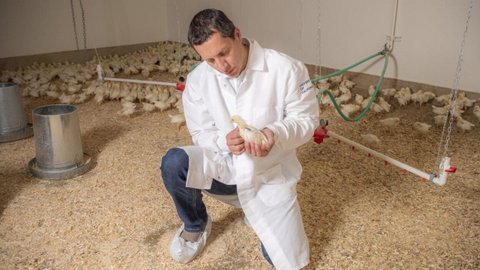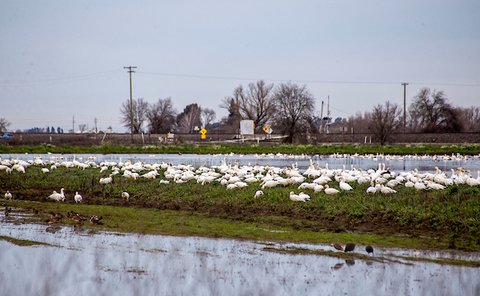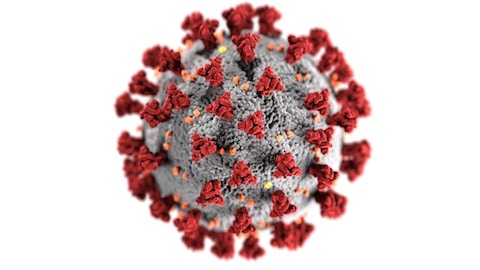
04 Jun Experts Warn About Deadly Bird Flu and ‘More Aggressive’ COVID Variant

UC Davis poultry veterinarian Rodrigo Gallardo examines a chicken. (UC Davis School of Veterinary Medicine photo via Ethnic Media Services)
By America Leon
The latest avian flu outbreak and COVID variant have medical experts concerned as our immune systems may not be equipped to handle them.
Ethnic Media Services hosted a trio of doctors with expertise in virology and human and animal medicine in a May 24 press briefing to discuss what people need to know about the two viruses.
The current avian influenza outbreak began in 2020, but according to Dr. Maurice Pitesky, associate professor at the UC Davis School of Veterinary Medicine, “normal methods of control” have not mitigated the issue well enough.
Avian influenza, also known as bird flu, is a respiratory virus whose variants result from interactions between waterfowl during migration. These waterfowl can transmit the virus to domesticated animals in dairy and poultry farms by “roosting and feeding in areas where we have human agriculture,” said Pitesky.
The virus has demonstrated a “remarkable ability to move into various species,” said Pitesky. According to the Centers for Disease Control and Prevention, it can be transmitted from animals to humans through infectious air particles and “prolonged and unprotected contact” with infected animals.
Logistical challenges and unanswered questions prevent vaccination from being a viable solution. Pitesky said that the “asymptomatic spread of the virus” is a potential consequence of vaccination because vaccines do not prevent infection; they protect against disease. Furthermore, attempting to vaccinate 8 billion chickens would not be an easy feat.
Pitesky presented some ideas to address the issue. “Surveillance of wildlife” is a more holistic and innovative approach that could help “identify which farms are at highest risk based upon which farms have the highest abundance of waterfowl habitat and waterfowl abundance around them.”
Locally, two chickens at a live bird market in San Francisco that were not showing symptoms were found to have H5N1 during routine testing, but local health experts told the public not to worry.
When the virus reaches the dairy and poultry industries, human transmission is a growing concern. Dr. Peter Chin-Hong, professor of medicine at UC San Francisco, said, “In the last 30 years or so we’ve already had about 880 cases [of avian influenza] in humans with about a 50% fatality rate.” As of May 24, there had been “two confirmed human cases” in the U.S., but Chin-Hong warned that this number was expected to increase.
In fact, it did less than a week later. A third case was announced May 30, and the actual number of people with the virus may be higher.
“We don’t even know how many people have asymptomatic infection,” said Chin-Hong.
Workers worried about the potential consequences of reporting their symptoms may also affect the number of reported cases. Chin-Hong explained that fear of deportation among immigrant workers and not having paid sick leave may also prevent some workers from revealing their symptoms.
Economic factors are another possible barrier. “There’s probably a fear that if you diagnose a bunch of people with infection, even if they have no symptoms, you may have to shut down that farm for some time,” he said.
Although the initial two observed human cases during this surge of avian influenza only resulted in minor symptoms and ended with recovery, Chin-Hong warns that because “we are not used to seeing this kind of infection” and “we don’t have the necessary immune system to target it,” the anticipated increase in serious avian influenza cases is dangerous.
“What we know about avian flu, this particular one, H5N1, in the global experience, is that it’s very, very deadly and it appears like a regular bad flu except that the fatality rate is higher,” he said.
Considering the health risks associated with avian influenza, the U.S. Department of Agriculture has taken measures to attempt to protect workers. They have provided “some funding for masks and personal protective equipment,” said Pitesky. However, using such equipment may not be ideal for individuals working in hot summer weather, increasing potential risks for workers in these agricultural industries.
There has been some misinformation regarding avian influenza’s ability to infect people who consume animal products contaminated with the virus. Chin-Hong dispelled this incorrect notion, explaining that pasteurization “did seem to kill this particular virus.” However, “we don’t have assurance about raw milk or cheese made from raw unpasteurized milk.”
Chin-Hong emphasized the importance of protective regulations, including making personal protective equipment accessible and considering “sick leave or income assurance” and “immigration status amnesty.” The U.S. government also “approved the production of 4.8 million doses of vaccine,” which are expected to be available this summer. Prioritizing dairy workers, elderly people, and young people in vaccination efforts could be beneficial.
Still, we should understand that “wherever the virus grows, the virus can change and the virus can adapt,” said Dr. Ben Neuman, professor of biology at Texas A&M University. Whether this surge in avian influenza results in a pandemic remains to be seen.
And while that threat looms, COVID is still hanging over our heads.
>>>From Our Archives: ‘People Are Really Over It,’ But COVID Isn’t Over
Neuman said the newly emergent FLiRT sub-variants of the omicron variant “is one of the more aggressive versions of the virus that we have ever seen” and “is at the top of the scale in terms of immune resistance.”
FLiRT sub-variants are expected to be able to infect the already vaccinated population. Nonetheless, Neuman says vaccination is still the best way to protect oneself from the virus and prevent serious illness or death.
As the FDA attempts to deal with these rapidly emerging variants, vaccine rollout is another prevalent point of discussion. The vaccine rollout route the FDA appears to be taking is “a once annual vaccination” during the “back to school and winter season,” said Neuman. However, this could be risky as the virus is notoriously unpredictable in terms of when infection rates peak during the year.
With an advisory committee meeting Wednesday, the FDA is expected to soon make new recommendations on COVID vaccinations.






Anonymous
Posted at 12:14h, 05 Juneinteresting read, will definitely be on the lookout for this!